Literature Review: Evaluating Financial Management Strategies in Banks
VerifiedAdded on 2023/04/20
|16
|4284
|139
Literature Review
AI Summary
This literature review evaluates the financial management strategies employed by major Australian banks, including National Australia Bank (NAB), Commonwealth Bank (CBA), Australia and New Zealand Banking Group (ANZ), and Westpac (WBC). It examines the influence of these strategies on organizational performance, the importance of stakeholder participation, and the impact of government involvement. The review explores various aspects of financial management, such as cash flow, working capital, and profitability management, and their effects on overall productivity. It synthesizes findings from multiple studies, considering perspectives from economics, psychology, and sociology to provide a comprehensive understanding of financial management practices in the banking sector and their implications for performance and sustainability. Desklib provides access to past papers and solved assignments for students.
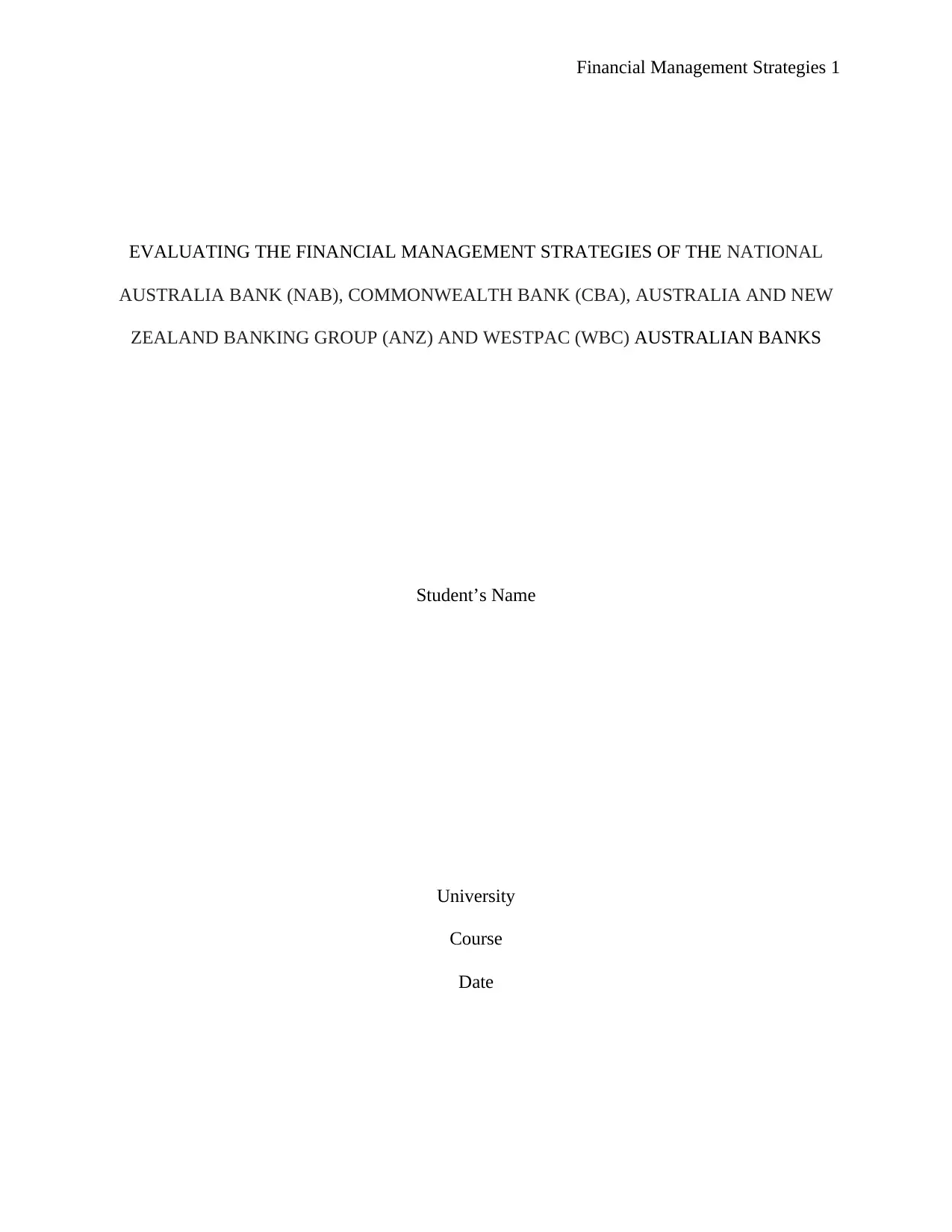
Financial Management Strategies 1
EVALUATING THE FINANCIAL MANAGEMENT STRATEGIES OF THE NATIONAL
AUSTRALIA BANK (NAB), COMMONWEALTH BANK (CBA), AUSTRALIA AND NEW
ZEALAND BANKING GROUP (ANZ) AND WESTPAC (WBC) AUSTRALIAN BANKS
Student’s Name
University
Course
Date
EVALUATING THE FINANCIAL MANAGEMENT STRATEGIES OF THE NATIONAL
AUSTRALIA BANK (NAB), COMMONWEALTH BANK (CBA), AUSTRALIA AND NEW
ZEALAND BANKING GROUP (ANZ) AND WESTPAC (WBC) AUSTRALIAN BANKS
Student’s Name
University
Course
Date
Paraphrase This Document
Need a fresh take? Get an instant paraphrase of this document with our AI Paraphraser
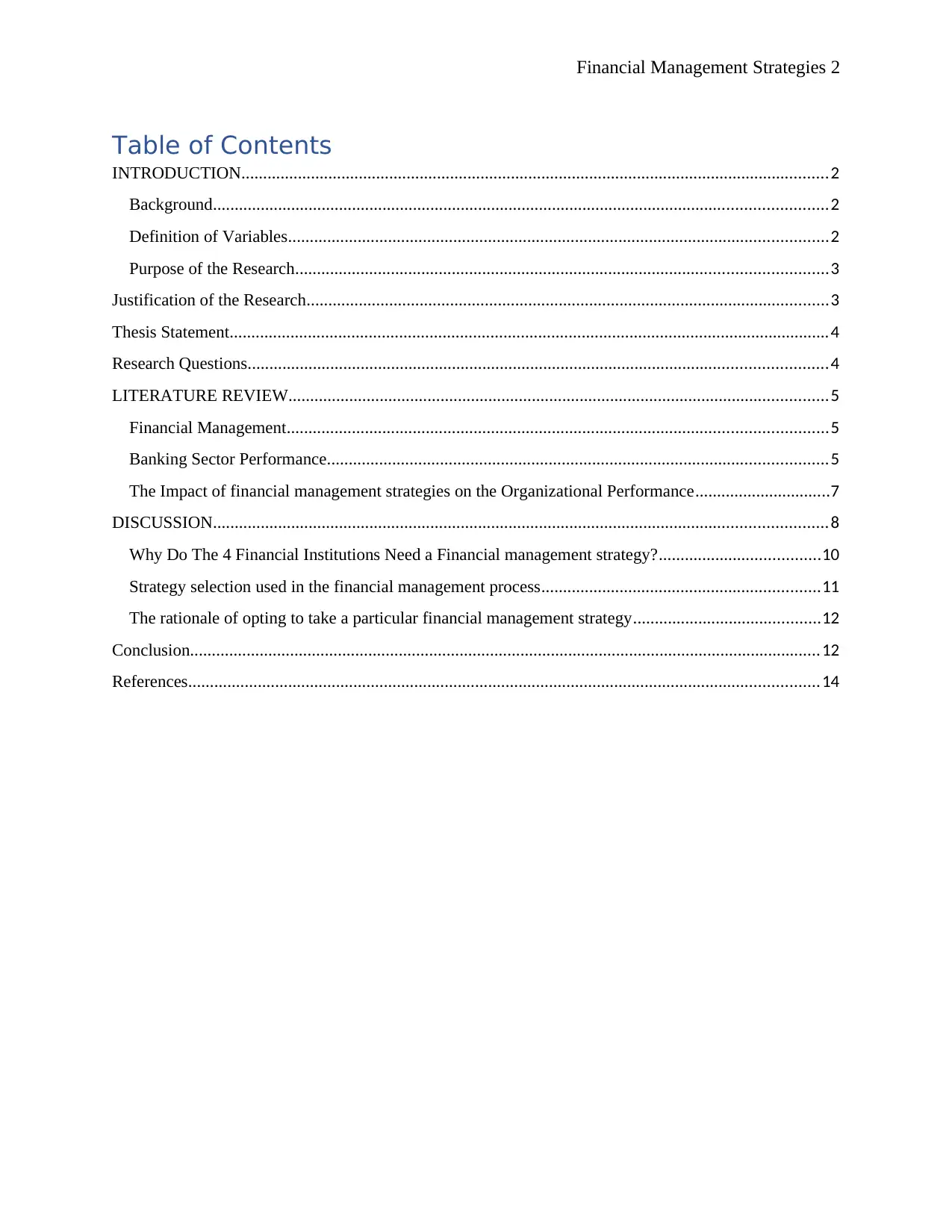
Financial Management Strategies 2
Table of Contents
INTRODUCTION.......................................................................................................................................2
Background.............................................................................................................................................2
Definition of Variables............................................................................................................................2
Purpose of the Research..........................................................................................................................3
Justification of the Research........................................................................................................................3
Thesis Statement..........................................................................................................................................4
Research Questions.....................................................................................................................................4
LITERATURE REVIEW............................................................................................................................5
Financial Management............................................................................................................................5
Banking Sector Performance...................................................................................................................5
The Impact of financial management strategies on the Organizational Performance...............................7
DISCUSSION.............................................................................................................................................8
Why Do The 4 Financial Institutions Need a Financial management strategy?.....................................10
Strategy selection used in the financial management process................................................................11
The rationale of opting to take a particular financial management strategy...........................................12
Conclusion.................................................................................................................................................12
References.................................................................................................................................................14
Table of Contents
INTRODUCTION.......................................................................................................................................2
Background.............................................................................................................................................2
Definition of Variables............................................................................................................................2
Purpose of the Research..........................................................................................................................3
Justification of the Research........................................................................................................................3
Thesis Statement..........................................................................................................................................4
Research Questions.....................................................................................................................................4
LITERATURE REVIEW............................................................................................................................5
Financial Management............................................................................................................................5
Banking Sector Performance...................................................................................................................5
The Impact of financial management strategies on the Organizational Performance...............................7
DISCUSSION.............................................................................................................................................8
Why Do The 4 Financial Institutions Need a Financial management strategy?.....................................10
Strategy selection used in the financial management process................................................................11
The rationale of opting to take a particular financial management strategy...........................................12
Conclusion.................................................................................................................................................12
References.................................................................................................................................................14

Financial Management Strategies 3
INTRODUCTION
Background
There is a developing acknowledgment of the significance of value to advancement and financial
management, and the banking sector perceive value as a focal objective for their financial
operations. In any case, while a financial strategy is utilized instinctively being developed
discussions and programming, it appears that its significance isn't obviously comprehended. This
is reflected in regularly shallow investigation about what financial strategy is and what ought to
be done to accomplish it. Its significance is perceived, yet the approach needs to accomplish it
are not reliably or lucidly investigated.
In National Australia Bank (NAB), Commonwealth Bank (CBA) and Australia and New
Zealand Banking Group (ANZ) and Westpac (WBC) value originates from the possibility of
good financial that the four banks ought to be treated as equivalents. Pondering value can enable
the banks to choose how to disperse products and enterprises crosswise over society, considering
the state in charge of its impact over how merchandise and ventures are disseminated in a general
public, and utilizing this impact to guarantee reasonable treatment for all nationals in Australia.
Applying these financial strategies in an explicit nation setting includes hard decisions, and
inserting dialogs of distributive savings into residential political and strategy discusses is vital to
banking sector advancement.
Definition of Variables
For the purpose of these research, there was an application of both independent and dependent
variables. The independent variable in this research was financial management strategies while
the dependent variable in this study was performance in National Australia Bank (NAB),
Commonwealth Bank (CBA) and Australia and New Zealand Banking Group (ANZ) and
INTRODUCTION
Background
There is a developing acknowledgment of the significance of value to advancement and financial
management, and the banking sector perceive value as a focal objective for their financial
operations. In any case, while a financial strategy is utilized instinctively being developed
discussions and programming, it appears that its significance isn't obviously comprehended. This
is reflected in regularly shallow investigation about what financial strategy is and what ought to
be done to accomplish it. Its significance is perceived, yet the approach needs to accomplish it
are not reliably or lucidly investigated.
In National Australia Bank (NAB), Commonwealth Bank (CBA) and Australia and New
Zealand Banking Group (ANZ) and Westpac (WBC) value originates from the possibility of
good financial that the four banks ought to be treated as equivalents. Pondering value can enable
the banks to choose how to disperse products and enterprises crosswise over society, considering
the state in charge of its impact over how merchandise and ventures are disseminated in a general
public, and utilizing this impact to guarantee reasonable treatment for all nationals in Australia.
Applying these financial strategies in an explicit nation setting includes hard decisions, and
inserting dialogs of distributive savings into residential political and strategy discusses is vital to
banking sector advancement.
Definition of Variables
For the purpose of these research, there was an application of both independent and dependent
variables. The independent variable in this research was financial management strategies while
the dependent variable in this study was performance in National Australia Bank (NAB),
Commonwealth Bank (CBA) and Australia and New Zealand Banking Group (ANZ) and
⊘ This is a preview!⊘
Do you want full access?
Subscribe today to unlock all pages.

Trusted by 1+ million students worldwide
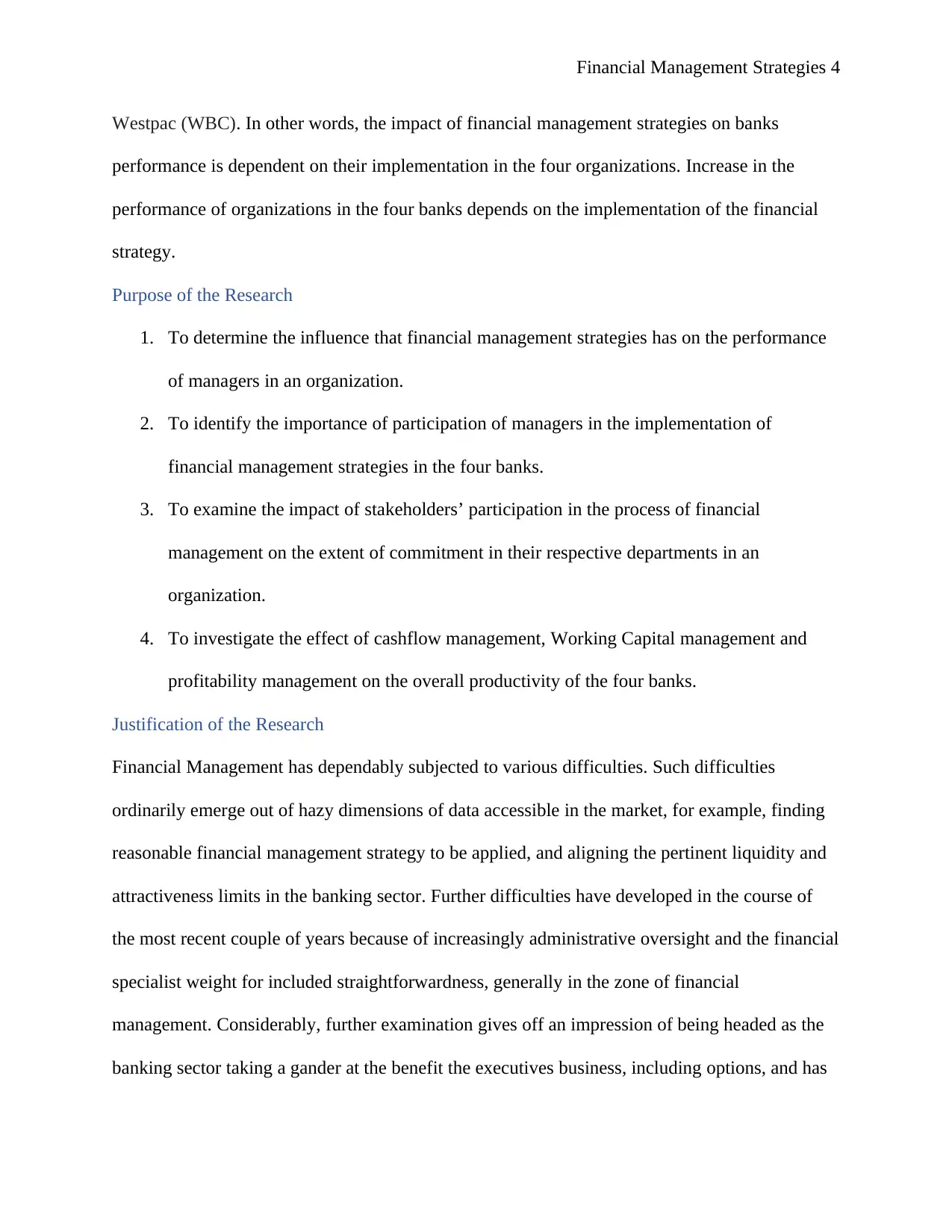
Financial Management Strategies 4
Westpac (WBC). In other words, the impact of financial management strategies on banks
performance is dependent on their implementation in the four organizations. Increase in the
performance of organizations in the four banks depends on the implementation of the financial
strategy.
Purpose of the Research
1. To determine the influence that financial management strategies has on the performance
of managers in an organization.
2. To identify the importance of participation of managers in the implementation of
financial management strategies in the four banks.
3. To examine the impact of stakeholders’ participation in the process of financial
management on the extent of commitment in their respective departments in an
organization.
4. To investigate the effect of cashflow management, Working Capital management and
profitability management on the overall productivity of the four banks.
Justification of the Research
Financial Management has dependably subjected to various difficulties. Such difficulties
ordinarily emerge out of hazy dimensions of data accessible in the market, for example, finding
reasonable financial management strategy to be applied, and aligning the pertinent liquidity and
attractiveness limits in the banking sector. Further difficulties have developed in the course of
the most recent couple of years because of increasingly administrative oversight and the financial
specialist weight for included straightforwardness, generally in the zone of financial
management. Considerably, further examination gives off an impression of being headed as the
banking sector taking a gander at the benefit the executives business, including options, and has
Westpac (WBC). In other words, the impact of financial management strategies on banks
performance is dependent on their implementation in the four organizations. Increase in the
performance of organizations in the four banks depends on the implementation of the financial
strategy.
Purpose of the Research
1. To determine the influence that financial management strategies has on the performance
of managers in an organization.
2. To identify the importance of participation of managers in the implementation of
financial management strategies in the four banks.
3. To examine the impact of stakeholders’ participation in the process of financial
management on the extent of commitment in their respective departments in an
organization.
4. To investigate the effect of cashflow management, Working Capital management and
profitability management on the overall productivity of the four banks.
Justification of the Research
Financial Management has dependably subjected to various difficulties. Such difficulties
ordinarily emerge out of hazy dimensions of data accessible in the market, for example, finding
reasonable financial management strategy to be applied, and aligning the pertinent liquidity and
attractiveness limits in the banking sector. Further difficulties have developed in the course of
the most recent couple of years because of increasingly administrative oversight and the financial
specialist weight for included straightforwardness, generally in the zone of financial
management. Considerably, further examination gives off an impression of being headed as the
banking sector taking a gander at the benefit the executives business, including options, and has
Paraphrase This Document
Need a fresh take? Get an instant paraphrase of this document with our AI Paraphraser
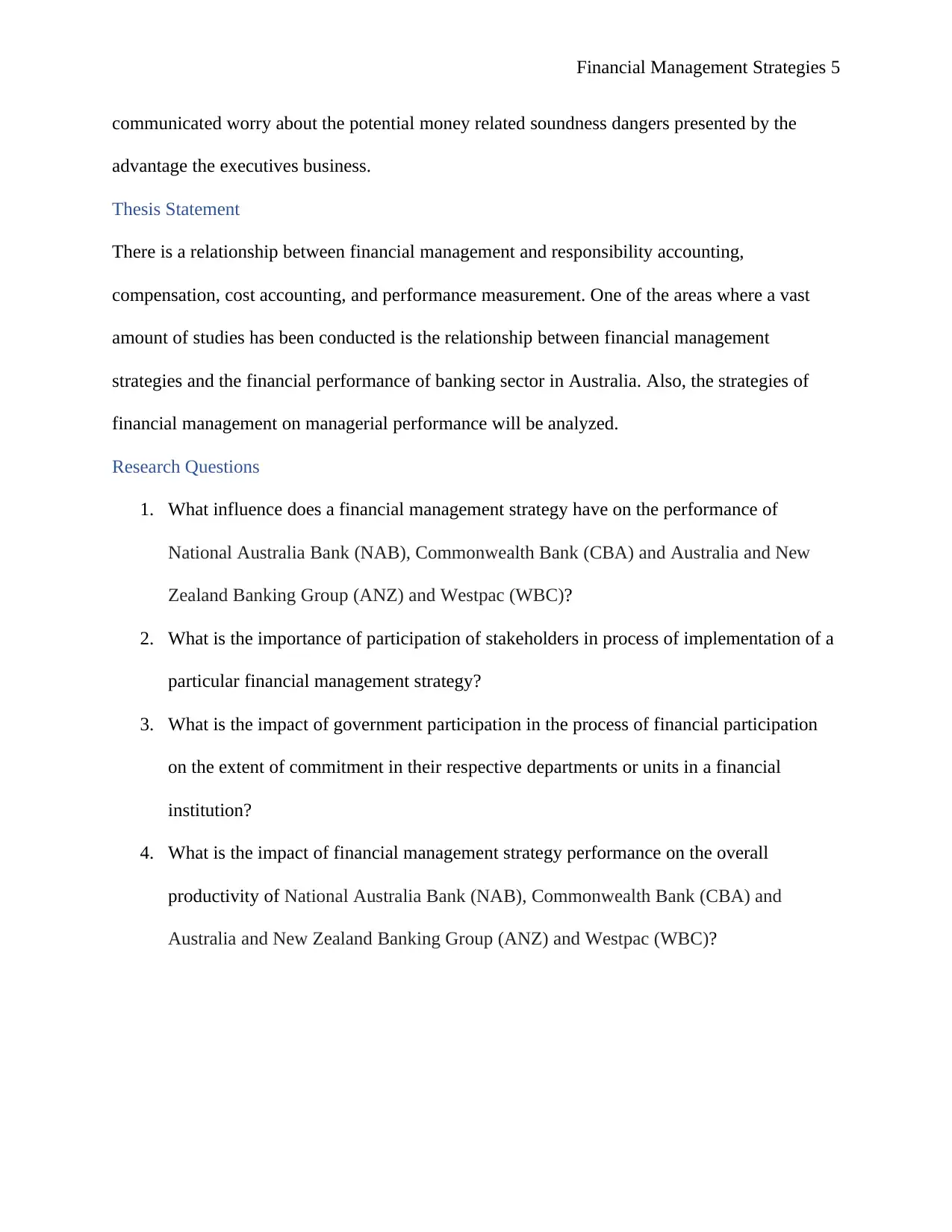
Financial Management Strategies 5
communicated worry about the potential money related soundness dangers presented by the
advantage the executives business.
Thesis Statement
There is a relationship between financial management and responsibility accounting,
compensation, cost accounting, and performance measurement. One of the areas where a vast
amount of studies has been conducted is the relationship between financial management
strategies and the financial performance of banking sector in Australia. Also, the strategies of
financial management on managerial performance will be analyzed.
Research Questions
1. What influence does a financial management strategy have on the performance of
National Australia Bank (NAB), Commonwealth Bank (CBA) and Australia and New
Zealand Banking Group (ANZ) and Westpac (WBC)?
2. What is the importance of participation of stakeholders in process of implementation of a
particular financial management strategy?
3. What is the impact of government participation in the process of financial participation
on the extent of commitment in their respective departments or units in a financial
institution?
4. What is the impact of financial management strategy performance on the overall
productivity of National Australia Bank (NAB), Commonwealth Bank (CBA) and
Australia and New Zealand Banking Group (ANZ) and Westpac (WBC)?
communicated worry about the potential money related soundness dangers presented by the
advantage the executives business.
Thesis Statement
There is a relationship between financial management and responsibility accounting,
compensation, cost accounting, and performance measurement. One of the areas where a vast
amount of studies has been conducted is the relationship between financial management
strategies and the financial performance of banking sector in Australia. Also, the strategies of
financial management on managerial performance will be analyzed.
Research Questions
1. What influence does a financial management strategy have on the performance of
National Australia Bank (NAB), Commonwealth Bank (CBA) and Australia and New
Zealand Banking Group (ANZ) and Westpac (WBC)?
2. What is the importance of participation of stakeholders in process of implementation of a
particular financial management strategy?
3. What is the impact of government participation in the process of financial participation
on the extent of commitment in their respective departments or units in a financial
institution?
4. What is the impact of financial management strategy performance on the overall
productivity of National Australia Bank (NAB), Commonwealth Bank (CBA) and
Australia and New Zealand Banking Group (ANZ) and Westpac (WBC)?
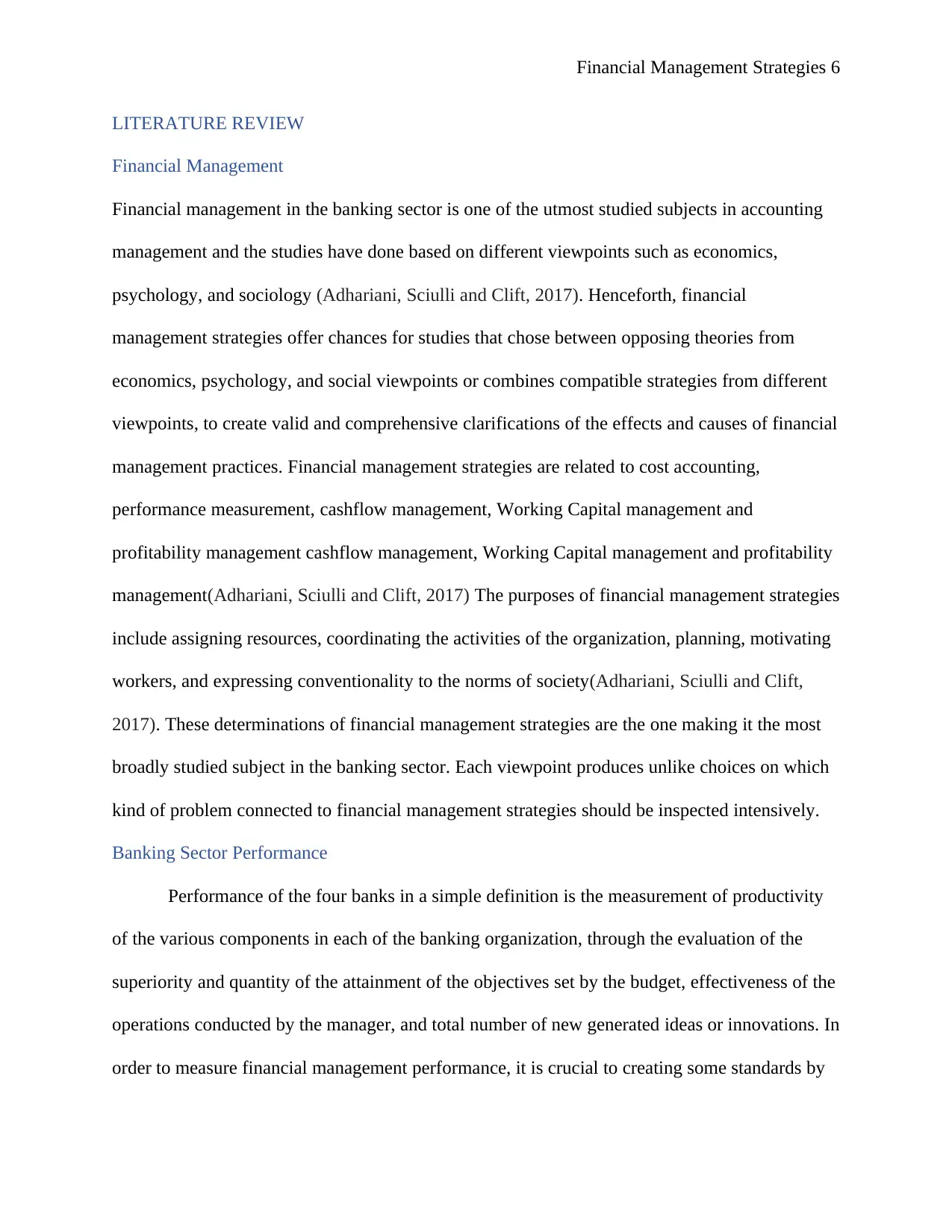
Financial Management Strategies 6
LITERATURE REVIEW
Financial Management
Financial management in the banking sector is one of the utmost studied subjects in accounting
management and the studies have done based on different viewpoints such as economics,
psychology, and sociology (Adhariani, Sciulli and Clift, 2017). Henceforth, financial
management strategies offer chances for studies that chose between opposing theories from
economics, psychology, and social viewpoints or combines compatible strategies from different
viewpoints, to create valid and comprehensive clarifications of the effects and causes of financial
management practices. Financial management strategies are related to cost accounting,
performance measurement, cashflow management, Working Capital management and
profitability management cashflow management, Working Capital management and profitability
management(Adhariani, Sciulli and Clift, 2017) The purposes of financial management strategies
include assigning resources, coordinating the activities of the organization, planning, motivating
workers, and expressing conventionality to the norms of society(Adhariani, Sciulli and Clift,
2017). These determinations of financial management strategies are the one making it the most
broadly studied subject in the banking sector. Each viewpoint produces unlike choices on which
kind of problem connected to financial management strategies should be inspected intensively.
Banking Sector Performance
Performance of the four banks in a simple definition is the measurement of productivity
of the various components in each of the banking organization, through the evaluation of the
superiority and quantity of the attainment of the objectives set by the budget, effectiveness of the
operations conducted by the manager, and total number of new generated ideas or innovations. In
order to measure financial management performance, it is crucial to creating some standards by
LITERATURE REVIEW
Financial Management
Financial management in the banking sector is one of the utmost studied subjects in accounting
management and the studies have done based on different viewpoints such as economics,
psychology, and sociology (Adhariani, Sciulli and Clift, 2017). Henceforth, financial
management strategies offer chances for studies that chose between opposing theories from
economics, psychology, and social viewpoints or combines compatible strategies from different
viewpoints, to create valid and comprehensive clarifications of the effects and causes of financial
management practices. Financial management strategies are related to cost accounting,
performance measurement, cashflow management, Working Capital management and
profitability management cashflow management, Working Capital management and profitability
management(Adhariani, Sciulli and Clift, 2017) The purposes of financial management strategies
include assigning resources, coordinating the activities of the organization, planning, motivating
workers, and expressing conventionality to the norms of society(Adhariani, Sciulli and Clift,
2017). These determinations of financial management strategies are the one making it the most
broadly studied subject in the banking sector. Each viewpoint produces unlike choices on which
kind of problem connected to financial management strategies should be inspected intensively.
Banking Sector Performance
Performance of the four banks in a simple definition is the measurement of productivity
of the various components in each of the banking organization, through the evaluation of the
superiority and quantity of the attainment of the objectives set by the budget, effectiveness of the
operations conducted by the manager, and total number of new generated ideas or innovations. In
order to measure financial management performance, it is crucial to creating some standards by
⊘ This is a preview!⊘
Do you want full access?
Subscribe today to unlock all pages.

Trusted by 1+ million students worldwide
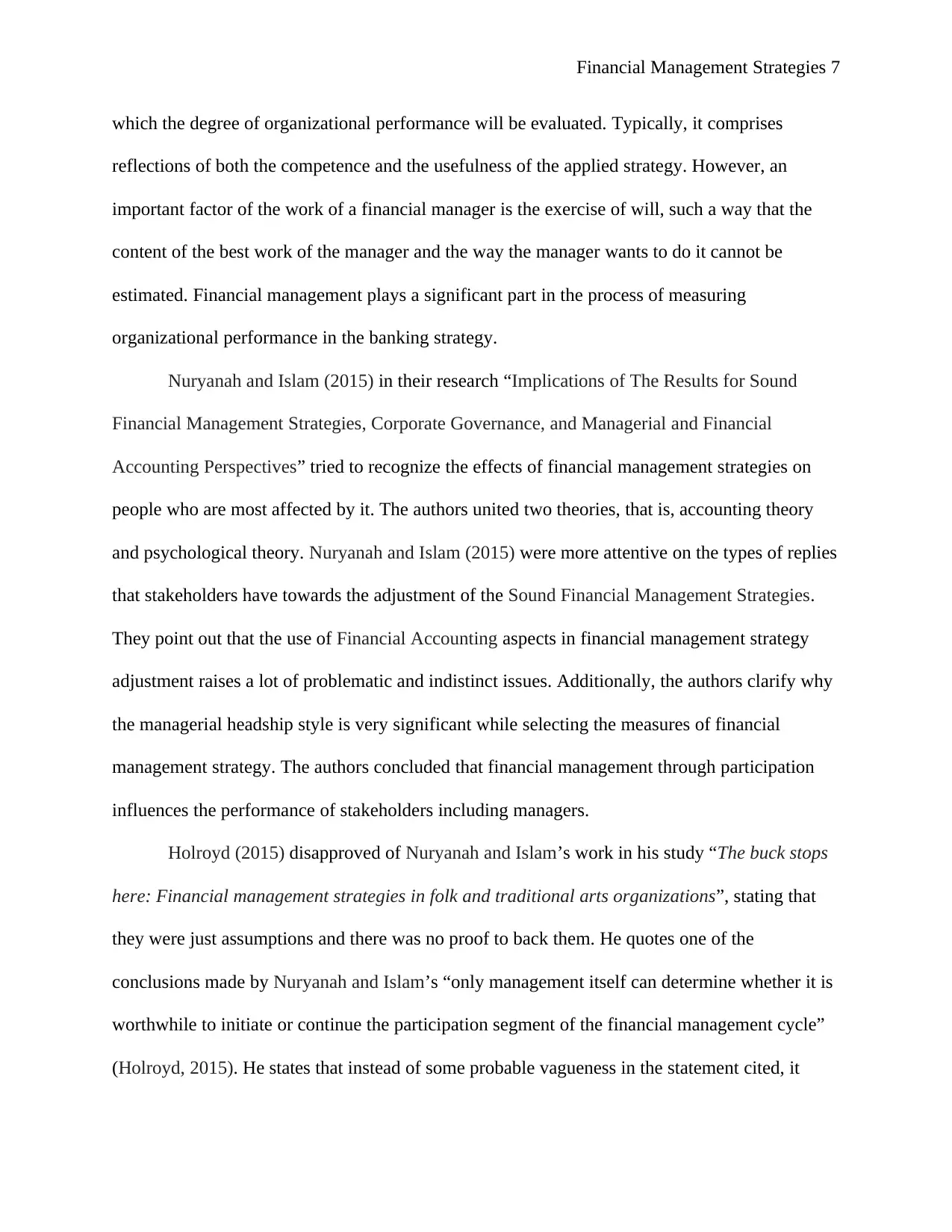
Financial Management Strategies 7
which the degree of organizational performance will be evaluated. Typically, it comprises
reflections of both the competence and the usefulness of the applied strategy. However, an
important factor of the work of a financial manager is the exercise of will, such a way that the
content of the best work of the manager and the way the manager wants to do it cannot be
estimated. Financial management plays a significant part in the process of measuring
organizational performance in the banking strategy.
Nuryanah and Islam (2015) in their research “Implications of The Results for Sound
Financial Management Strategies, Corporate Governance, and Managerial and Financial
Accounting Perspectives” tried to recognize the effects of financial management strategies on
people who are most affected by it. The authors united two theories, that is, accounting theory
and psychological theory. Nuryanah and Islam (2015) were more attentive on the types of replies
that stakeholders have towards the adjustment of the Sound Financial Management Strategies.
They point out that the use of Financial Accounting aspects in financial management strategy
adjustment raises a lot of problematic and indistinct issues. Additionally, the authors clarify why
the managerial headship style is very significant while selecting the measures of financial
management strategy. The authors concluded that financial management through participation
influences the performance of stakeholders including managers.
Holroyd (2015) disapproved of Nuryanah and Islam’s work in his study “The buck stops
here: Financial management strategies in folk and traditional arts organizations”, stating that
they were just assumptions and there was no proof to back them. He quotes one of the
conclusions made by Nuryanah and Islam’s “only management itself can determine whether it is
worthwhile to initiate or continue the participation segment of the financial management cycle”
(Holroyd, 2015). He states that instead of some probable vagueness in the statement cited, it
which the degree of organizational performance will be evaluated. Typically, it comprises
reflections of both the competence and the usefulness of the applied strategy. However, an
important factor of the work of a financial manager is the exercise of will, such a way that the
content of the best work of the manager and the way the manager wants to do it cannot be
estimated. Financial management plays a significant part in the process of measuring
organizational performance in the banking strategy.
Nuryanah and Islam (2015) in their research “Implications of The Results for Sound
Financial Management Strategies, Corporate Governance, and Managerial and Financial
Accounting Perspectives” tried to recognize the effects of financial management strategies on
people who are most affected by it. The authors united two theories, that is, accounting theory
and psychological theory. Nuryanah and Islam (2015) were more attentive on the types of replies
that stakeholders have towards the adjustment of the Sound Financial Management Strategies.
They point out that the use of Financial Accounting aspects in financial management strategy
adjustment raises a lot of problematic and indistinct issues. Additionally, the authors clarify why
the managerial headship style is very significant while selecting the measures of financial
management strategy. The authors concluded that financial management through participation
influences the performance of stakeholders including managers.
Holroyd (2015) disapproved of Nuryanah and Islam’s work in his study “The buck stops
here: Financial management strategies in folk and traditional arts organizations”, stating that
they were just assumptions and there was no proof to back them. He quotes one of the
conclusions made by Nuryanah and Islam’s “only management itself can determine whether it is
worthwhile to initiate or continue the participation segment of the financial management cycle”
(Holroyd, 2015). He states that instead of some probable vagueness in the statement cited, it
Paraphrase This Document
Need a fresh take? Get an instant paraphrase of this document with our AI Paraphraser

Financial Management Strategies 8
looks almost unbearable for Nuryanah and Islam to support involvement without including the
argument of headship style. Holroyd states that the social-psychological proof the connection
between efficiency and corporate governance is almost completely attained from a data from the
survey, therefore, it is not likely to assess whether high-efficiency results to high financial
management or accounting morale leads to high efficiency in the banking sector.
Though Holroyd (2015) criticized some of the conclusions made by Nuryanah and Islam
(2015), Adhariani, Sciulli and Clift (2017) in their research “Financial management and
corporate governance from the feminist ethics of care perspective” attempted to find out
effective and comprehensive clarifications of some of the conclusions made by Nuryanah and
Islam. In their investigational study, Adhariani, Sciulli and Clift inspects the connection between
involvement in financial management strategies to performance and motivation among
stakeholders in industrial companies. Adhariani, Sciulli and Clift applied the expectancy theory
to identify the connection between the three things. The expectancy theory they used was applied
to propose parameters for approximating and postulating financial management concepts. In the
study, they evidenced one of the assumptions raised by Nuryanah and Islam which proved that
involvement of financial stakeholders and the financial management strategy performance are
significantly completely related, however, the connection between involvement and performance
via ethics has a little clarification of this and is because the association between involvement and
motivation is negligible.
The Impact of financial management strategies on the Organizational Performance
The effect that financial management strategies has on organizational performance,
particularly on the banking sector, can only be investigated through the stakeholder's involved in
the process of implementing either cashflow management, Working Capital management or
looks almost unbearable for Nuryanah and Islam to support involvement without including the
argument of headship style. Holroyd states that the social-psychological proof the connection
between efficiency and corporate governance is almost completely attained from a data from the
survey, therefore, it is not likely to assess whether high-efficiency results to high financial
management or accounting morale leads to high efficiency in the banking sector.
Though Holroyd (2015) criticized some of the conclusions made by Nuryanah and Islam
(2015), Adhariani, Sciulli and Clift (2017) in their research “Financial management and
corporate governance from the feminist ethics of care perspective” attempted to find out
effective and comprehensive clarifications of some of the conclusions made by Nuryanah and
Islam. In their investigational study, Adhariani, Sciulli and Clift inspects the connection between
involvement in financial management strategies to performance and motivation among
stakeholders in industrial companies. Adhariani, Sciulli and Clift applied the expectancy theory
to identify the connection between the three things. The expectancy theory they used was applied
to propose parameters for approximating and postulating financial management concepts. In the
study, they evidenced one of the assumptions raised by Nuryanah and Islam which proved that
involvement of financial stakeholders and the financial management strategy performance are
significantly completely related, however, the connection between involvement and performance
via ethics has a little clarification of this and is because the association between involvement and
motivation is negligible.
The Impact of financial management strategies on the Organizational Performance
The effect that financial management strategies has on organizational performance,
particularly on the banking sector, can only be investigated through the stakeholder's involved in
the process of implementing either cashflow management, Working Capital management or
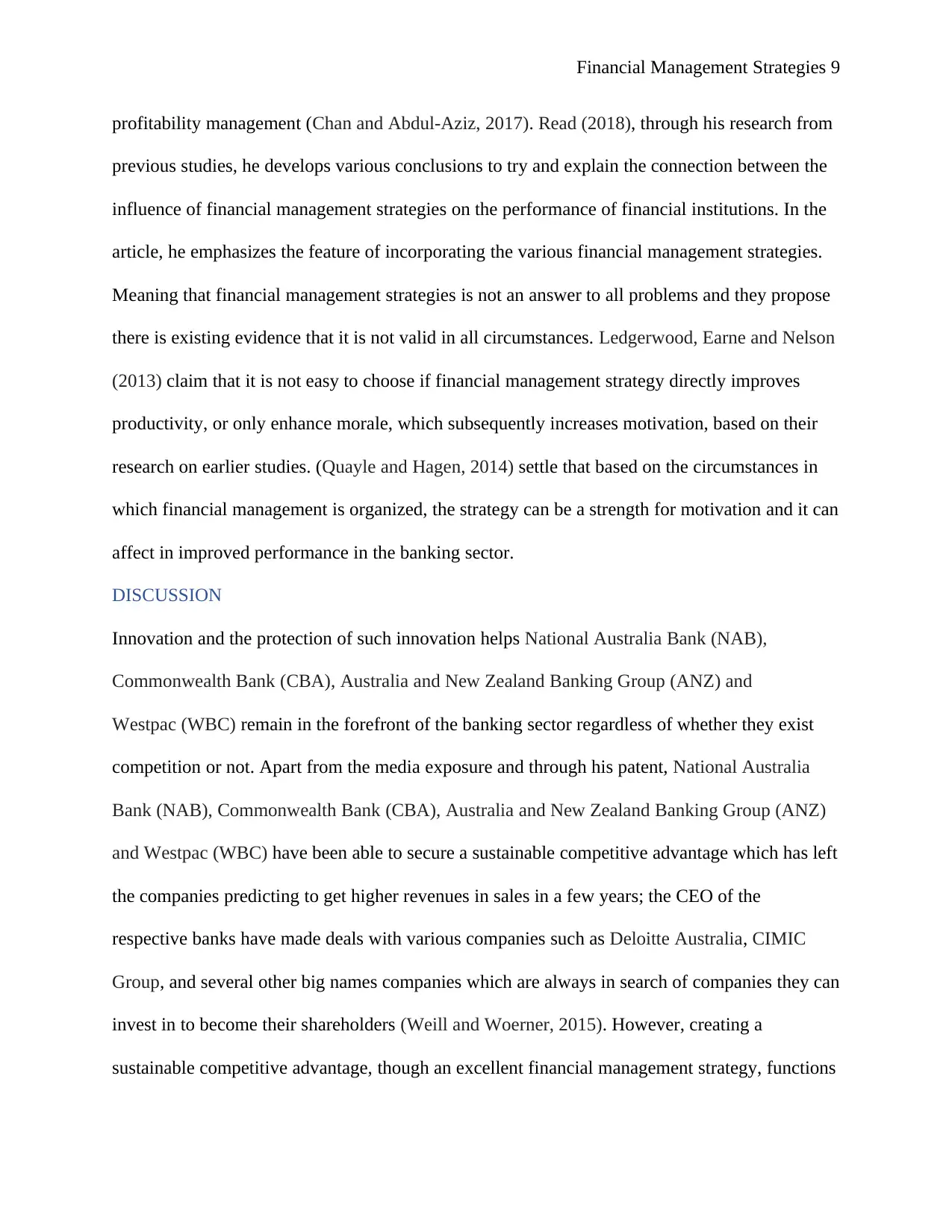
Financial Management Strategies 9
profitability management (Chan and Abdul-Aziz, 2017). Read (2018), through his research from
previous studies, he develops various conclusions to try and explain the connection between the
influence of financial management strategies on the performance of financial institutions. In the
article, he emphasizes the feature of incorporating the various financial management strategies.
Meaning that financial management strategies is not an answer to all problems and they propose
there is existing evidence that it is not valid in all circumstances. Ledgerwood, Earne and Nelson
(2013) claim that it is not easy to choose if financial management strategy directly improves
productivity, or only enhance morale, which subsequently increases motivation, based on their
research on earlier studies. (Quayle and Hagen, 2014) settle that based on the circumstances in
which financial management is organized, the strategy can be a strength for motivation and it can
affect in improved performance in the banking sector.
DISCUSSION
Innovation and the protection of such innovation helps National Australia Bank (NAB),
Commonwealth Bank (CBA), Australia and New Zealand Banking Group (ANZ) and
Westpac (WBC) remain in the forefront of the banking sector regardless of whether they exist
competition or not. Apart from the media exposure and through his patent, National Australia
Bank (NAB), Commonwealth Bank (CBA), Australia and New Zealand Banking Group (ANZ)
and Westpac (WBC) have been able to secure a sustainable competitive advantage which has left
the companies predicting to get higher revenues in sales in a few years; the CEO of the
respective banks have made deals with various companies such as Deloitte Australia, CIMIC
Group, and several other big names companies which are always in search of companies they can
invest in to become their shareholders (Weill and Woerner, 2015). However, creating a
sustainable competitive advantage, though an excellent financial management strategy, functions
profitability management (Chan and Abdul-Aziz, 2017). Read (2018), through his research from
previous studies, he develops various conclusions to try and explain the connection between the
influence of financial management strategies on the performance of financial institutions. In the
article, he emphasizes the feature of incorporating the various financial management strategies.
Meaning that financial management strategies is not an answer to all problems and they propose
there is existing evidence that it is not valid in all circumstances. Ledgerwood, Earne and Nelson
(2013) claim that it is not easy to choose if financial management strategy directly improves
productivity, or only enhance morale, which subsequently increases motivation, based on their
research on earlier studies. (Quayle and Hagen, 2014) settle that based on the circumstances in
which financial management is organized, the strategy can be a strength for motivation and it can
affect in improved performance in the banking sector.
DISCUSSION
Innovation and the protection of such innovation helps National Australia Bank (NAB),
Commonwealth Bank (CBA), Australia and New Zealand Banking Group (ANZ) and
Westpac (WBC) remain in the forefront of the banking sector regardless of whether they exist
competition or not. Apart from the media exposure and through his patent, National Australia
Bank (NAB), Commonwealth Bank (CBA), Australia and New Zealand Banking Group (ANZ)
and Westpac (WBC) have been able to secure a sustainable competitive advantage which has left
the companies predicting to get higher revenues in sales in a few years; the CEO of the
respective banks have made deals with various companies such as Deloitte Australia, CIMIC
Group, and several other big names companies which are always in search of companies they can
invest in to become their shareholders (Weill and Woerner, 2015). However, creating a
sustainable competitive advantage, though an excellent financial management strategy, functions
⊘ This is a preview!⊘
Do you want full access?
Subscribe today to unlock all pages.

Trusted by 1+ million students worldwide
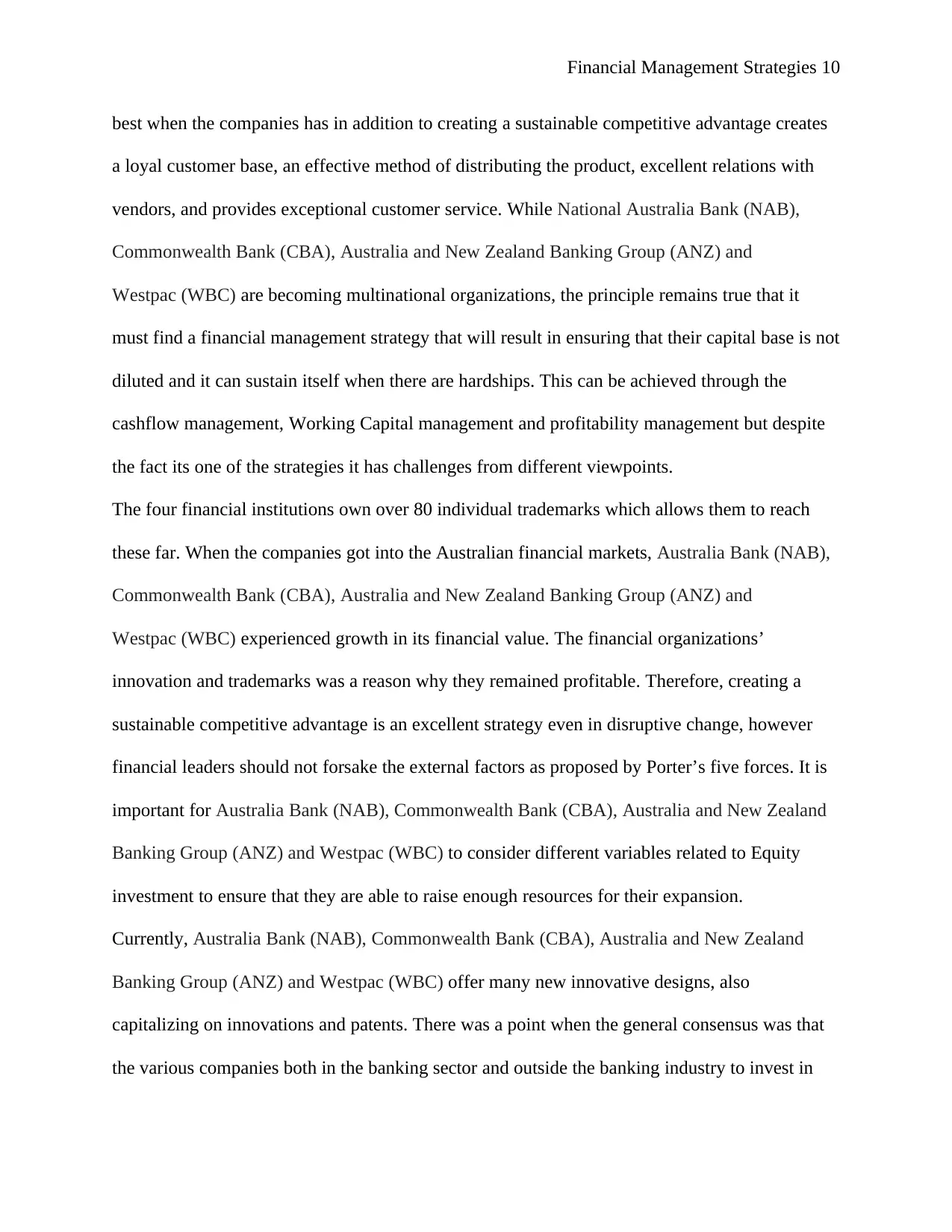
Financial Management Strategies 10
best when the companies has in addition to creating a sustainable competitive advantage creates
a loyal customer base, an effective method of distributing the product, excellent relations with
vendors, and provides exceptional customer service. While National Australia Bank (NAB),
Commonwealth Bank (CBA), Australia and New Zealand Banking Group (ANZ) and
Westpac (WBC) are becoming multinational organizations, the principle remains true that it
must find a financial management strategy that will result in ensuring that their capital base is not
diluted and it can sustain itself when there are hardships. This can be achieved through the
cashflow management, Working Capital management and profitability management but despite
the fact its one of the strategies it has challenges from different viewpoints.
The four financial institutions own over 80 individual trademarks which allows them to reach
these far. When the companies got into the Australian financial markets, Australia Bank (NAB),
Commonwealth Bank (CBA), Australia and New Zealand Banking Group (ANZ) and
Westpac (WBC) experienced growth in its financial value. The financial organizations’
innovation and trademarks was a reason why they remained profitable. Therefore, creating a
sustainable competitive advantage is an excellent strategy even in disruptive change, however
financial leaders should not forsake the external factors as proposed by Porter’s five forces. It is
important for Australia Bank (NAB), Commonwealth Bank (CBA), Australia and New Zealand
Banking Group (ANZ) and Westpac (WBC) to consider different variables related to Equity
investment to ensure that they are able to raise enough resources for their expansion.
Currently, Australia Bank (NAB), Commonwealth Bank (CBA), Australia and New Zealand
Banking Group (ANZ) and Westpac (WBC) offer many new innovative designs, also
capitalizing on innovations and patents. There was a point when the general consensus was that
the various companies both in the banking sector and outside the banking industry to invest in
best when the companies has in addition to creating a sustainable competitive advantage creates
a loyal customer base, an effective method of distributing the product, excellent relations with
vendors, and provides exceptional customer service. While National Australia Bank (NAB),
Commonwealth Bank (CBA), Australia and New Zealand Banking Group (ANZ) and
Westpac (WBC) are becoming multinational organizations, the principle remains true that it
must find a financial management strategy that will result in ensuring that their capital base is not
diluted and it can sustain itself when there are hardships. This can be achieved through the
cashflow management, Working Capital management and profitability management but despite
the fact its one of the strategies it has challenges from different viewpoints.
The four financial institutions own over 80 individual trademarks which allows them to reach
these far. When the companies got into the Australian financial markets, Australia Bank (NAB),
Commonwealth Bank (CBA), Australia and New Zealand Banking Group (ANZ) and
Westpac (WBC) experienced growth in its financial value. The financial organizations’
innovation and trademarks was a reason why they remained profitable. Therefore, creating a
sustainable competitive advantage is an excellent strategy even in disruptive change, however
financial leaders should not forsake the external factors as proposed by Porter’s five forces. It is
important for Australia Bank (NAB), Commonwealth Bank (CBA), Australia and New Zealand
Banking Group (ANZ) and Westpac (WBC) to consider different variables related to Equity
investment to ensure that they are able to raise enough resources for their expansion.
Currently, Australia Bank (NAB), Commonwealth Bank (CBA), Australia and New Zealand
Banking Group (ANZ) and Westpac (WBC) offer many new innovative designs, also
capitalizing on innovations and patents. There was a point when the general consensus was that
the various companies both in the banking sector and outside the banking industry to invest in
Paraphrase This Document
Need a fresh take? Get an instant paraphrase of this document with our AI Paraphraser

Financial Management Strategies 11
financial policies to ensure that the equity level moves up for sustainability of the organization as
it gives the worthiness of these institutions.
Schreck (2015) examines the dominant financial management approaches – competitive forces,
strategic conflict, resource-based perspective – and introduces the dynamic capabilities approach
which is based on the Working Capital management in an organization. Each approach, in this
writer’s view, has its merit; that is, each approach should be equally considered as they are
complementary towards realization of the stability of the banking sector. But the goal should not
be forgotten: company need to remain profitable and valuable.
Why Do The 4 Financial Institutions Need a Financial management strategy?
The products and services offered by Australia Bank (NAB), Commonwealth Bank (CBA),
Australia and New Zealand Banking Group (ANZ) and Westpac (WBC) are distinguishable, as
the main competition is from both within and without the banking industry. Therefore, there is
the competitive advantage of product differentiation, technologically driven and the traditional
banking sector (Catlin, Scanlan and Willmott, 2015). Also, there is noted consumer preference
for technologically driven financial institutions which are convenient thus giving these four
banks an upper hand over the competitors which is more convenient and efficient. However,
quality control assessment in these four banking institutions is done regularly to maintain the
competitive advantages.
They are prescribing that the oversight of the business ought to be reinforced through the
selection of a 'microprudential introduction'. Financial management is surely inside the extent of
this proposition. The different difficulties incorporate Importance of portfolio valuation to these
four banking firms, Increased direction and norms, Increased control and benchmarks, Real
difficulties in financial management valuation, and financial management techniques.
financial policies to ensure that the equity level moves up for sustainability of the organization as
it gives the worthiness of these institutions.
Schreck (2015) examines the dominant financial management approaches – competitive forces,
strategic conflict, resource-based perspective – and introduces the dynamic capabilities approach
which is based on the Working Capital management in an organization. Each approach, in this
writer’s view, has its merit; that is, each approach should be equally considered as they are
complementary towards realization of the stability of the banking sector. But the goal should not
be forgotten: company need to remain profitable and valuable.
Why Do The 4 Financial Institutions Need a Financial management strategy?
The products and services offered by Australia Bank (NAB), Commonwealth Bank (CBA),
Australia and New Zealand Banking Group (ANZ) and Westpac (WBC) are distinguishable, as
the main competition is from both within and without the banking industry. Therefore, there is
the competitive advantage of product differentiation, technologically driven and the traditional
banking sector (Catlin, Scanlan and Willmott, 2015). Also, there is noted consumer preference
for technologically driven financial institutions which are convenient thus giving these four
banks an upper hand over the competitors which is more convenient and efficient. However,
quality control assessment in these four banking institutions is done regularly to maintain the
competitive advantages.
They are prescribing that the oversight of the business ought to be reinforced through the
selection of a 'microprudential introduction'. Financial management is surely inside the extent of
this proposition. The different difficulties incorporate Importance of portfolio valuation to these
four banking firms, Increased direction and norms, Increased control and benchmarks, Real
difficulties in financial management valuation, and financial management techniques.
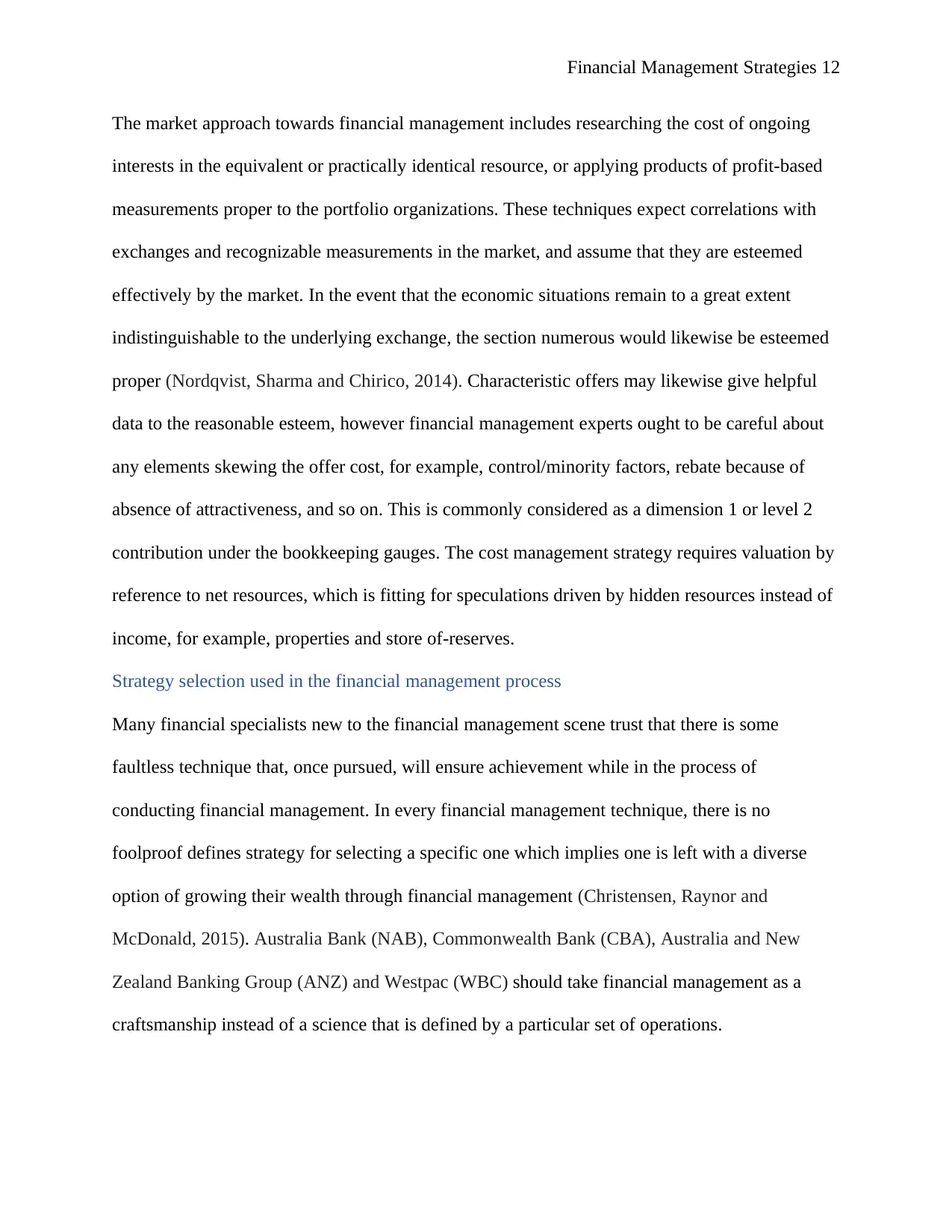
Financial Management Strategies 12
The market approach towards financial management includes researching the cost of ongoing
interests in the equivalent or practically identical resource, or applying products of profit-based
measurements proper to the portfolio organizations. These techniques expect correlations with
exchanges and recognizable measurements in the market, and assume that they are esteemed
effectively by the market. In the event that the economic situations remain to a great extent
indistinguishable to the underlying exchange, the section numerous would likewise be esteemed
proper (Nordqvist, Sharma and Chirico, 2014). Characteristic offers may likewise give helpful
data to the reasonable esteem, however financial management experts ought to be careful about
any elements skewing the offer cost, for example, control/minority factors, rebate because of
absence of attractiveness, and so on. This is commonly considered as a dimension 1 or level 2
contribution under the bookkeeping gauges. The cost management strategy requires valuation by
reference to net resources, which is fitting for speculations driven by hidden resources instead of
income, for example, properties and store of-reserves.
Strategy selection used in the financial management process
Many financial specialists new to the financial management scene trust that there is some
faultless technique that, once pursued, will ensure achievement while in the process of
conducting financial management. In every financial management technique, there is no
foolproof defines strategy for selecting a specific one which implies one is left with a diverse
option of growing their wealth through financial management (Christensen, Raynor and
McDonald, 2015). Australia Bank (NAB), Commonwealth Bank (CBA), Australia and New
Zealand Banking Group (ANZ) and Westpac (WBC) should take financial management as a
craftsmanship instead of a science that is defined by a particular set of operations.
The market approach towards financial management includes researching the cost of ongoing
interests in the equivalent or practically identical resource, or applying products of profit-based
measurements proper to the portfolio organizations. These techniques expect correlations with
exchanges and recognizable measurements in the market, and assume that they are esteemed
effectively by the market. In the event that the economic situations remain to a great extent
indistinguishable to the underlying exchange, the section numerous would likewise be esteemed
proper (Nordqvist, Sharma and Chirico, 2014). Characteristic offers may likewise give helpful
data to the reasonable esteem, however financial management experts ought to be careful about
any elements skewing the offer cost, for example, control/minority factors, rebate because of
absence of attractiveness, and so on. This is commonly considered as a dimension 1 or level 2
contribution under the bookkeeping gauges. The cost management strategy requires valuation by
reference to net resources, which is fitting for speculations driven by hidden resources instead of
income, for example, properties and store of-reserves.
Strategy selection used in the financial management process
Many financial specialists new to the financial management scene trust that there is some
faultless technique that, once pursued, will ensure achievement while in the process of
conducting financial management. In every financial management technique, there is no
foolproof defines strategy for selecting a specific one which implies one is left with a diverse
option of growing their wealth through financial management (Christensen, Raynor and
McDonald, 2015). Australia Bank (NAB), Commonwealth Bank (CBA), Australia and New
Zealand Banking Group (ANZ) and Westpac (WBC) should take financial management as a
craftsmanship instead of a science that is defined by a particular set of operations.
⊘ This is a preview!⊘
Do you want full access?
Subscribe today to unlock all pages.

Trusted by 1+ million students worldwide
1 out of 16
Related Documents
Your All-in-One AI-Powered Toolkit for Academic Success.
+13062052269
info@desklib.com
Available 24*7 on WhatsApp / Email
![[object Object]](/_next/static/media/star-bottom.7253800d.svg)
Unlock your academic potential
Copyright © 2020–2025 A2Z Services. All Rights Reserved. Developed and managed by ZUCOL.




